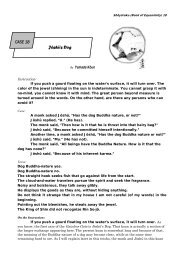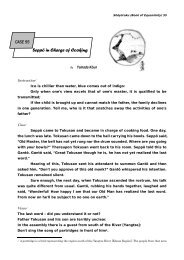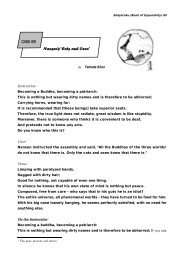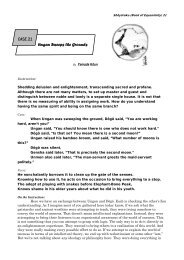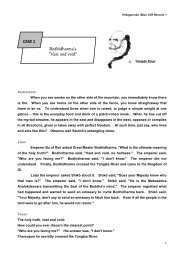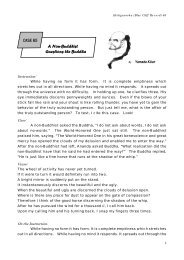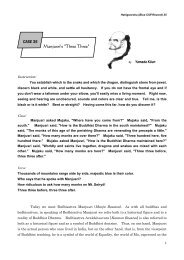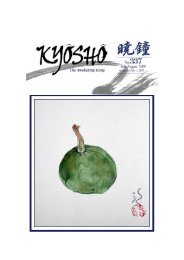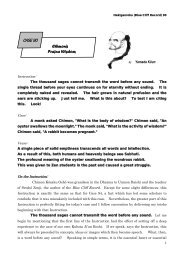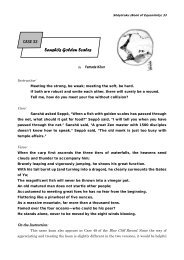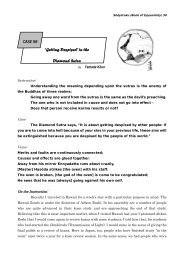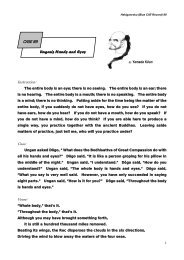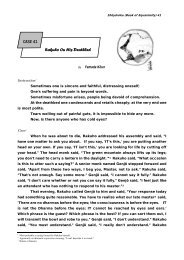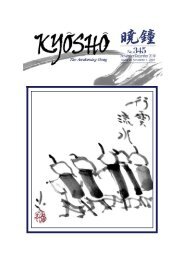Shoyoroku 42
Shoyoroku 42
Shoyoroku 42
Create successful ePaper yourself
Turn your PDF publications into a flip-book with our unique Google optimized e-Paper software.
Shôyôroku (Book of Equanimity) <strong>42</strong><br />
CASE <strong>42</strong><br />
Nanyô and the Water Jug<br />
By Yamada Kôun<br />
Instruction:<br />
Washing the meal bowls, pouring water into the jug:<br />
These are all Dharma teaching and Buddha-work.<br />
Carrying firewood and transporting water:<br />
These are nothing but supernatural deeds and miraculous functions.<br />
Why don't you understand the actions that emanate light and shake the<br />
earth?<br />
Case:<br />
A monk asked National Teacher Chû of Nanyô, “What is the essential<br />
body 1 of Vairocana Buddha 2 ?” National Teacher said, “Pass me that water jug.”<br />
The monk passed him the water jug. National Teacher said, “Put it back where it<br />
was.” The monk asked again, “What is the essential body of Vairocana Buddha?”<br />
National Teacher said, “The old Buddha is long gone.”<br />
Verse:<br />
Birds fly in the sky,<br />
Fish stay in the water:<br />
They have forgotten rivers and lakes,<br />
Have acquired their will in clouds and sky.<br />
If you have a single thread of doubting mind,<br />
You are already a thousand miles away from what you are facing.<br />
How many can appreciate the benevolence received and requite it?<br />
On the Instruction:<br />
Speaking about this case, Yasutani Roshi has said that it is quite easy to “see,” in the<br />
sense that even when it is explained intellectually it is relatively easy to understand. That<br />
1<br />
The so-called “Dharma-body” or dharmakaya.<br />
2<br />
The principal Buddha.
Shôyôroku (Book of Equanimity) <strong>42</strong><br />
could well be the case. He also says that it can often happen that someone will suddenly realize<br />
directly upon reading or hearing such an easy case. In that sense, you should carefully examine<br />
this particular case.<br />
Washing the meal bowls, pouring water into the jug:<br />
These are all Dharma teaching and Buddha-work. The “Dharma teaching and<br />
Buddha-work” (hômon-butsuji) can be understand as meaning Buddhism or the<br />
Buddha-dharma. It’s essential Buddhism. You might refer to it as the ultimate of the Buddha<br />
way or that very Buddha way itself.<br />
Carrying firewood and transporting water:<br />
These are nothing but supernatural deeds and miraculous functions. In old<br />
times, people didn’t have gas ranges or running water in their homes, so they had to go out to<br />
the hills and gather firewood and to the river to get water, or dig a well, all of which was quite<br />
hard work. They probably drew water from a public well and brought it home. This matter of<br />
washing the meal bowls also appears in Case 7 of the Gateless Gate (Jôshû’s “Wash Your<br />
Bowls”).<br />
A monk asked Jôshû in all earnestness, “I have just entered this monastery. I beg you,<br />
Master, please give me instructions.” Jôshû asked, “Have you eaten your rice gruel yet?” The<br />
monk answered, “Yes, I have.” Jôshû said, “Then wash your bowls.” The monk attained some<br />
realization.<br />
Yasutani Roshi says that Jôshû’s question, “Have you eaten your rice gruel yet?” has<br />
another ring to it. He is asking the monk, “Have you realized kensho yet?” In reply, the monk<br />
says, “Yes, I have.” Here, it also means, “Yes, I have realized kensho.” Then Jôshû says, “Wash<br />
your bowls.” I remember Yasutani Roshi delivering a teisho on this koan when I first began<br />
practicing with him. We borrowed rooms in the home of Mr. Sasaki, an attorney, to hold a<br />
zazenkai. The monk is saying that he still has some slight memory of attaining kensho. In reply,<br />
Jôshû tells him to wipe away all traces of kensho. This is what is meant by washing your bowls.<br />
As long as there is still some idea of satori or kensho in your head, it is still not the real thing.<br />
Of course, you have to realize kensho, but upon having done so you must throw it away, so to<br />
speak. This is what is meant by Jôshû’s words, Yasutani Roshi said, and he told us that, if we<br />
looked at the koan this way, we would be free of error. In what sense? What has been said up to<br />
now is from the standpoint of practice and enlightenment (shushôhen), in which you practice,<br />
realize satori, and go on to rid yourself of that satori. From the standpoint of the essential<br />
world (honbunjô), however, it’s just: “Have you eaten your rice gruel yet?” and just “Then wash<br />
your bowls.” You have to clearly realize that fact of just washing the bowls. This itself is the full<br />
manifestation of the essential world. But if we’re not careful we’re apt to jump hastily to<br />
conclusions and skim over things, blithely assuming that everything is the full manifestation,<br />
without having actually realized it. This is what is known as buji-zen (lit. the Zen of no matter,<br />
or no realization). The most important matter to realize here is that this act of washing the<br />
bowls is a complete manifestation of our essential nature. But you must grasp this in actual<br />
2
Shôyôroku (Book of Equanimity) <strong>42</strong><br />
experience. This is known as satori. If this element of direct experience is lacking, and you<br />
simply assume intellectually that eating your rice and washing your bowls is Zen, that would<br />
be an error. This is buji-zen, Zen lacking the aspect of actual experience. That being so,<br />
Yasutani Roshi’s believed that people should at least understand that other Case in the<br />
Gateless Gate from the standpoint of practice and enlightenment (shushôhen). I can still<br />
vividly remember him speaking about this matter in his teisho and the whole zazenkai was<br />
quite an impressive experience for me.<br />
Returning now to the Instruction for today’s koan, we must understand these lines<br />
from the essential point of view, and not just in terms of practice, but I just wanted to mention<br />
here that this line about “washing the meal bowls” originally comes from that other koan with<br />
Jôshû.<br />
The second part about “pouring water into the jug” is originally found in Case 15 of the<br />
koan collection known as the Record of the Empty Hall (Kyodôroku).<br />
Sekisô Keisho Zenji was a dharma successor of Dôgo Zenji, himself a disciple of<br />
Yakusan Igen Zenji, who was a dharma successor of Sekitô Kisen. Sekitô was a dharma<br />
successor of Seigen Gyôshi Zenji, himself a direct dharma successor of the Sixth Patriarch. One<br />
day Sekisô asked Dôgo, “What is enlightenment that meets the eye?” The expression<br />
“enlightenment that meets the eye” (sokumoku-bodai) means that everything that meets the<br />
eye is bodhi wisdom, which can be considered as the Supreme Way or our essential nature.<br />
Everything that meets the eye is the essential world. “How is that?” Sekisô asks. There are<br />
probably similar expressions in the sutras. Everything that meets the eye is the full revelation<br />
of the true fact. In reply, Dôgo said, “Novice (shami).” The novice said, “Yes, master”. Dôgo said,<br />
“Add some water to the washbasin.” This is no other than “enlightenment that meets the eye”<br />
(sokumoku-bodai). But we shouldn’t understand this superficially. You must clearly realize that<br />
adding water to the washbasin is itself no other than the true revelation of your true self.<br />
Please be careful of buji-zen. There is also the expression genjô-kôan, which means that each<br />
thing in the phenomenal world is a koan. It can be seen as the world of our true self or true<br />
nature. In other words, each thing in the phenomenal world is the complete manifestation of<br />
the essential world. This is how things are also explained in Zen circles. So, if there is a Zen<br />
exchange, something from the phenomenal world is brought up. At funerals in the Soto School,<br />
there is often recitation of a poem (ge), which also brings up something from the phenomenal<br />
world. If your eye is open for it, there is no doubt that each thing is the manifestation of the<br />
essential world. But I am asking here if the monk who recites such a poem as part of the<br />
ceremony by which the deceased person is led into the world of the dead (indô) has truly<br />
realized that. In most cases I think they haven’t. They just know that they won’t make a<br />
mistake if they simply bring up something from the phenomenal world. But this is buji-zen, the<br />
Zen lacking a real enlightenment experience. If you simply accept that as understanding, such<br />
a superficial understanding has no power to save you or give you comfort when a real calamity<br />
occurs, for example, when you are told you have cancer. It is only when you have realized that<br />
3
Shôyôroku (Book of Equanimity) <strong>42</strong><br />
essential world directly that you can achieve true peace of mind, even in such a situation. If you<br />
simply approach this matter of the genjô-kôan superficially, it will be of no use to you in a<br />
clinch. You have to experientially grasp the real world of emptiness. There is the poem:<br />
“Buddhism is the handle of the sliding door, the pine tree on the peak, the flint-and-steel pouch,<br />
the cry of the bush warbler.” You might think Buddhism is something very complicated, but the<br />
poet can quickly jump from the door handle to the pine on the mountaintop. It’s the flint and<br />
steel used to make a fire and stored in a pouch, it’s the cry of the bush warbler. Actually,<br />
anything you say is OK, if you truly understand. I wonder if the person who wrote this poem<br />
really knew. Perhaps not. Seen from this standpoint, “carrying firewood and transporting<br />
water” are the full manifestation of the Buddha-Way. These are known as “supernatural deeds<br />
and miraculous functions” (myôyô-jinzû). There is not a single thing that is not the<br />
supernatural deed of Buddha nature. What is Buddhism? You might think it is something very<br />
mysterious or spiritual, but that’s not the case. When you stand, that’s it. When you sit, that’s it.<br />
When you wash your tea bowl, that’s it. When you eat your rice, that’s it. There are no<br />
supernatural deeds and miraculous functions outside of these. Iida Tôin Roshi says that the act<br />
of cooking rice when you are hungry is itself a supernatural deed and miraculous function.<br />
That’s certainly the case. It is the activity of your Buddha nature. Raising a hand or lifting a<br />
foot, there is nothing that is not a supernatural deed and miraculous function.<br />
Why don't you understand the actions that emanate light and shake the<br />
earth? In other words, why don’t you understand the actions and functions of your essential<br />
self? The following case is now presented in order to bring us to an understanding of this<br />
matter. We are not aware that, from morning to evening, we are all engaged in supernatural<br />
deeds and miraculous functions. We do it unknowingly. In connection with this matter of<br />
emanating light and shaking the earth, I recall Case 39 of the Gateless Gate (Unmon and a<br />
Mistake in Speech). There was the Zen personage Chôsetsu Shusai. In modern Japanese the<br />
word “shusai” is used in referring to bright persons. In ancient China, however, the word<br />
referred to persons who had passed the examinations for government posts. In Japan it would<br />
be equal to passing the higher civil service examination. Government officials were then chosen<br />
from the persons who passed the examinations. Chôsetsu Shusai was extremely skilled in<br />
poetry. The examinations in ancient China mainly tested candidates on their writing skill and<br />
their ability to write outstanding poems. Mathematicians were not in great demand. Another<br />
person other than Chôsetsu Shusai who was outstanding in writing poems was the Zen master<br />
Zengetsu Zenji. It was he who told Chôsetsu Shusai to go and study with Sekiso Zenji. Chôsetsu<br />
Shusai did so and eventually realized enlightenment. He then wrote a poem expressing<br />
his enlightenment, a custom that was common in former times, since many of these people<br />
were outstanding poets. At any rate, that poem of Chôsetsu Shusai is the subject of this case<br />
from the Gateless Gate.<br />
The first line of the poem is: The radiance serenely illuminates the whole vast<br />
universe.<br />
4
Shôyôroku (Book of Equanimity) <strong>42</strong><br />
The words translated as “whole vast universe” (henkasha) can also mean the sands of<br />
the Ganges River, in the sense of innumerable and vast. The light penetrates throughout every<br />
grain of sand along the Ganges River. This is just a way of saying that it penetrates and<br />
illuminates the entire universe. The monk in the koan quoted this poem and was about to<br />
deliver his opinion on it. Maybe he wanted to say what a wonderful poem it was. But just in<br />
that moment Unmon interrupted him and said, “Aren’t those the words of Chôsetsu Shusai?”<br />
Of course, Unmon was familiar with the poem. The monk said, “Yes, they are.” Immediately<br />
Unmon replied, “You have slipped up in the words.” That’s quite an interesting reply. Why did<br />
the monk slip up in the words? It’s just like the present case. He didn’t know “the actions that<br />
emanate light and shake the earth.” His own true self is emanating light and shaking the earth,<br />
but he doesn’t know it. He is simply looking at the scenery and assuming these are the words of<br />
Chôsetsu Shusai. He is just considering things intellectually, but that’s an error. Why doesn’t<br />
he realize? Because concepts get in his way. Chôsetsu Shusai’s poem also contains this line:<br />
When no thought arises, total oneness is completely manifested.<br />
When no thought appears, that itself is the complete manifestation of the true self. The<br />
poem continues:<br />
If the six organs move even a little, it is covered with clouds.<br />
The six organs are the six senses. If our senses function even a little, it is hidden by<br />
clouds. In other words, the moon that is the light of our true self becomes hidden. You fail to<br />
realize the true fact, because you are thinking. When you practice zazen, you must put all<br />
thinking aside, otherwise your true self will not appear. If you are still operating through the<br />
medium of thought, it is just like a pane of glass, and not the real thing. You have to break<br />
through that glass. You are given the koan MU in order to break that glass. You use the drill of<br />
MU to drill a hole in that glass. Kensho is a matter of breaking that glass. Actually, there has<br />
never been any glass from the start.<br />
Why don't you understand the actions that emanate light and shake the earth?<br />
The reason is that concepts and thoughts get in the way. You have to put those concepts<br />
and thoughts aside when you practice.<br />
On the Case:<br />
A monk asked National Teacher Chû of Nanyô, “What is the essential body<br />
of Vairocana Buddha?” Since I have spoken about National Teacher Chû many times<br />
already, most of you are familiar with him. When you see the words National Teacher in a koan,<br />
it is referring to him in most cases. At the time of the Emperor Shukuso in the Tang Dynasty he<br />
made major contributions to Buddhism. ?? National Teacher Chû lived in the region that is<br />
modern-day Henan Province in China. The area was known then as Nanyang-fu, which<br />
included the mountain known as Hakugansan and the valley known as Tôshikoku. After<br />
having realized great enlightenment under the Sixth Patriarch, he entered this valley and did<br />
not emerge again for forty years. But, outstanding individual that he was, word spread of his<br />
5
Shôyôroku (Book of Equanimity) <strong>42</strong><br />
fame. It was not that he was advertising himself; it’s just that word got around that an<br />
outstanding Zen person was living in that valley. So the Emperor Shukusô wanted very much<br />
to meet him and sent repeated invitations to preach the dharma. But it wasn’t until the<br />
emperor had asked three times that the National Teacher finally acquiesced. He reflected that<br />
it would not be right to continue refusing if the Emperor was so insistent on seeing him, and<br />
finally emerged from seclusion. It was only then that he became National Teacher (i.e. the<br />
personal teacher of the emperor) and an outstanding Zen person. However, there was another<br />
person who had been practicing in seclusion in the valley together with the National Teacher,<br />
although I cannot recall his name. When the National Teacher finally acquiesced in response to<br />
the third request from the emperor, the other man tried very hard to dissuade him, feeling it<br />
unwise to emerge into the ordinary world. But the National Teacher had his own opinion on<br />
this matter, believing that it would not be to the benefit of saving other beings to simply remain<br />
in seclusion in the valley. “That might be all right for practice, but having practiced 40 years it’s<br />
time to emerge again,” he reasoned. But the other man insisted that it was too early and tried<br />
to stop him. Eventually he cut off all relations with the National Teacher. That other man is<br />
outstanding too in his own right.<br />
At any rate, the National Teacher then met the Emperor. It is said that he resided in<br />
the Luminous Abode Buddha Temple in present-day Loyang. According to the records, it is<br />
believed that he was over 80 when he died. In the year before he died, it is said that the future<br />
Kôbô Daishi was born in Japan, which would be in Japan’s Nara Period. Let us return now to<br />
the text of today’s koan:<br />
A monk asked National Teacher Chû of Nanyô, “What is the essential body<br />
of Vairocana Buddha?” Vairocana Buddha can be considered to be the Buddha of essential<br />
nature. There are the three kinds of Three Treasures, and without examining that doctrine, it’s<br />
difficult to understand what’s said here. The most basic method is to practice and realize Mu.<br />
To realize kensho is to realize the world of emptiness. But, surprisingly enough, that is<br />
completely one with the world of phenomena. Seen from this aspect, there is the world of<br />
phenomena. Seen from the other standpoint, there is nothing at all. But these are completely<br />
one. This aspect of emptiness is known as the Buddha of the Absolute Three Treasures. The<br />
Dharma of the Absolute Three Treasures is completely one. As for Buddha, Dharma and<br />
Sangha, all things in the phenomenal world are known as dharma. And they are completely<br />
one. This is the most fundamental Buddhist philosophy. Unless you clearly realize the Buddha<br />
of the Absolute Three Treasures, you do not really known Buddhism and cannot gain true<br />
peace of mind. Mu is given to students to practice in order to clearly grasp this fact. When you<br />
truly grasp MU, you are surprised. As Mumon says, “it will astonish the heavens and shake the<br />
earth.” This is actually what the monk in the koan is asking about when he asks what the<br />
essential body of Vairocana Buddha is. In the Shingon Sect of Buddhism in Japan this is known<br />
as Dainichi Nyorai. The monk is asking about our most fundamental Buddha.<br />
National Teacher said, “Pass me that water jug.” “Just bring me that water jug<br />
6
Shôyôroku (Book of Equanimity) <strong>42</strong><br />
over there.”<br />
The monk passed him the water jug. National Teacher said, “Put it back<br />
where it was.” Actually, everything has been revealed already and there’s nothing more to<br />
say. But the monk poses his question again.<br />
The monk asked again, “What is the essential body of Vairocana Buddha?”<br />
National Teacher said, “The old Buddha is long gone.” Just bringing the water jug.<br />
What is this? As I said before, it’s the complete revelation of your true self. Your true self is<br />
referred to here as Vairocana Buddha. It is the activity of that true self. But if you don’t realize<br />
it on the spot, it disappears.<br />
Then the master says, “put it back where it was.” Just putting it back. That is the<br />
essential body of Vairocana Buddha. It is the complete manifestation of the essential. You have<br />
to realize this clearly, not just thinking it out in your head. And if you miss seeing it, it will hide<br />
again. That is why National Teacher says, “The old Buddha is long gone.”<br />
On the Verse:<br />
Birds fly in the sky,<br />
Fish stay in the water:<br />
They have forgotten rivers and lakes,<br />
Have acquired their will in clouds and sky. It would be more logical to say, “birds<br />
fly in the sky, they have acquired their will in clouds and sky.” Then you would say, “fish stay in<br />
the water, they have forgotten rivers and lakes.” This would make it more understandable. It’s<br />
just like the Verse describes it.<br />
Birds fly through the sky and have acquired their will in clouds and sky, which means<br />
they are completely free and unfettered. Whether it’s a cloudy sky or a sunny sky, they’re<br />
equally free. That’s because they are completely one with the sky, even though they might<br />
appear to be two. Bird is no other than sky, that’s why it’s so free. What is this talking about? It<br />
means the self we normally think about. You might think that there is someone who somehow<br />
has essential nature, but actually self and essential nature are one. We are actually acting<br />
freely in essential nature. We are using our true self in complete freedom. Then you might<br />
believe there are two things: we persons and the true self. Actually, however, there is nothing<br />
that is not your true self. There is nothing that is not Buddha nature. Again and again we tend<br />
to see this as two different things. Consider the fish swimming around in the water. The poem<br />
says, “They have forgotten rivers and lakes.” That means the fish and the lake are one. But<br />
here again, we tend to see them as two separate things. When the fish is swimming in the lake,<br />
it forgets that there is water. It does not know it from the very beginning. When we are<br />
breathing normal air, we are not aware of its existence, but as soon as the air becomes bad, we<br />
immediately are aware of it. The example of the fish forgetting the water is given here to<br />
express how our true self and the phenomena of the phenomenal world are completely one.<br />
When I pick up this kotsu (short wooden stick), you might think that a stick has simply been<br />
7
Shôyôroku (Book of Equanimity) <strong>42</strong><br />
raised up, but actually this kotsu is the complete manifestation of our true self. This is said in<br />
consideration of the Main Case:<br />
“Pass me that water jug.” “Yes, master.” And he stands up and gets the water jug. You<br />
might think that the person giving the jug and the essential body of Vairocana are two different<br />
things, but lo and behold, they are one. This is what is being said here in the Verse.<br />
If you have a single thread of doubting mind,<br />
You are already a thousand miles away from what you are facing. In other<br />
words, concepts get in the way of the real fact. Actually, you are facing it all the time, but you<br />
are not aware of it. We are always one with essential nature, so that, if we speak in terms of<br />
“facing” we already divide it into two. But in terms of an expression, we can say that we are<br />
doing nothing else but “facing” it from morning to night. “Mutually meeting and mutually not<br />
knowing”, as the ancients used to say, or “speaking together and still not knowing.” Even<br />
though you might be speaking in the train with the person across from you, in many cases you<br />
don’t known anything about that person, and vice-versa. You could say the Verse is talking<br />
about such a state of affairs. In other words, if there is even a little bit of a delusive thought in<br />
your head, you are miles away from the true fact.<br />
How many can appreciate the benevolence received and requite it? Thanks<br />
to the benevolence of National Teacher Chû, the true fact can be grasped. It’s the same in our<br />
case: Thanks to the benevolence of the teacher, the true eye can be opened. As Yasutani Roshi<br />
says in his teisho on this case, when all is said and done, that itself is the benevolence of<br />
Vairocana Buddha. Because our true self is there, even if we do not realize it, that Buddha<br />
nature is welling up. That is because the thing we are seeking to grasp is with us from the very<br />
beginning. In that sense, we have to give thanks to the essential body of Vairocana Buddha.<br />
Christians also say God is with you, or the Lord be with you. But that God cannot be grasped in<br />
intellectual thought. You realize the blessing of God and give thanks to God. What should we<br />
do? The best way is to share the happiness you have gained with others. This is what is meant<br />
by requiting the benevolence. But how may people can really do that, the poet asks. If you<br />
realize you true nature and become happy, the desire should well up to make that happiness<br />
known to others. This is true requiting of benevolence. But you have to be careful here that you<br />
don’t fall prey to “Zen sickness” and preach about Zen to people who have no interest in such<br />
matters, bringing them with you to zazenkais when they are not the least interested. That’s a<br />
little different from requiting the benevolence. It’s more like a type of illness!<br />
8



